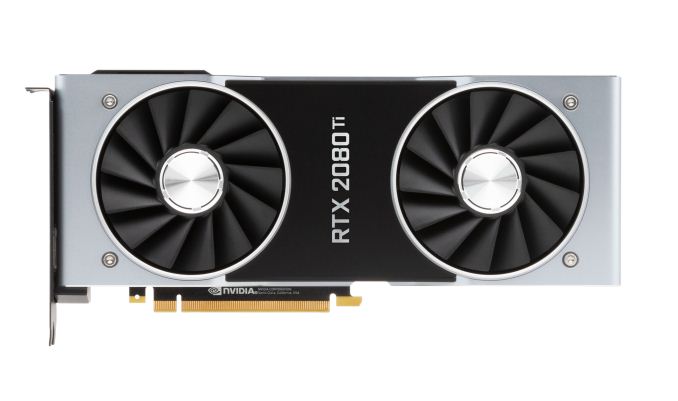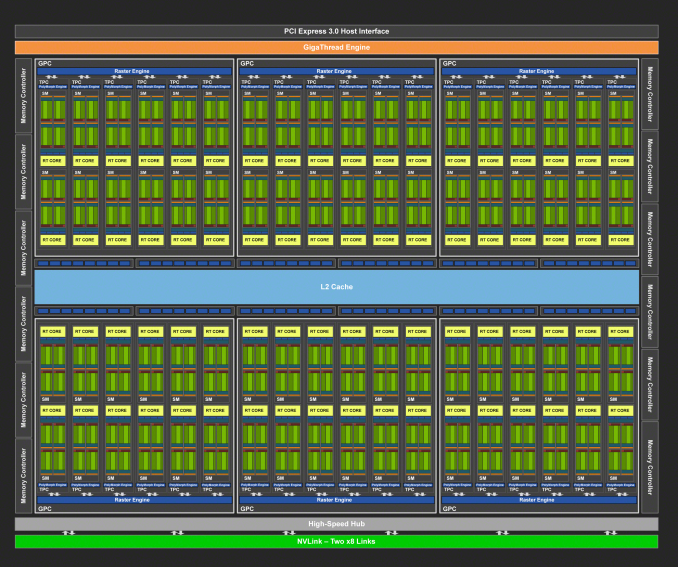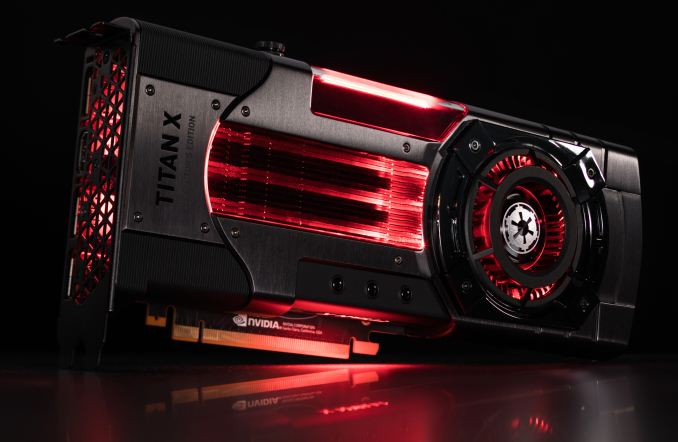The NVIDIA GeForce RTX 2080 Ti & RTX 2080 Founders Edition Review: Foundations For A Ray Traced Future
by Nate Oh on September 19, 2018 5:15 PM EST- Posted in
- GPUs
- Raytrace
- GeForce
- NVIDIA
- DirectX Raytracing
- Turing
- GeForce RTX

While it was roughly 2 years from Maxwell 2 to Pascal, the journey to Turing has felt much longer despite a similar 2 year gap. There’s some truth to the feeling: looking at the past couple years, there’s been basically every other possible development in the GPU space except next-generation gaming video cards, like Intel’s planned return to discrete graphics, NVIDIA’s Volta, and cryptomining-specific cards. Finally, at Gamescom 2018, NVIDIA announced the GeForce RTX 20 series, built on TSMC’s 12nm “FFN” process and powered by the Turing GPU architecture. Launching today with full general availability is just the GeForce RTX 2080, as the GeForce RTX 2080 Ti was delayed a week to the 27th, while the GeForce RTX 2070 is due in October. So up for review today is the GeForce RTX 2080 Ti and GeForce RTX 2080.
But a standard new generation of gaming GPUs this is not. The “GeForce RTX” brand, ousting the long-lived “GeForce GTX” moniker in favor of their announced “RTX technology” for real time ray tracing, aptly underlines NVIDIA’s new vision for the video card future. Like we saw last Friday, Turing and the GeForce RTX 20 series are designed around a set of specialized low-level hardware features and an intertwined ecosystem of supporting software currently in development. The central goal is a long-held dream of computer graphics researchers and engineers alike – real time ray tracing – and NVIDIA is aiming to bring that to gamers with their new cards, and willing to break some traditions on the way.
| NVIDIA GeForce Specification Comparison | ||||||
| RTX 2080 Ti | RTX 2080 | RTX 2070 | GTX 1080 | |||
| CUDA Cores | 4352 | 2944 | 2304 | 2560 | ||
| Core Clock | 1350MHz | 1515MHz | 1410MHz | 1607MHz | ||
| Boost Clock | 1545MHz FE: 1635MHz |
1710MHz FE: 1800MHz |
1620MHz FE: 1710MHz |
1733MHz | ||
| Memory Clock | 14Gbps GDDR6 | 14Gbps GDDR6 | 14Gbps GDDR6 | 10Gbps GDDR5X | ||
| Memory Bus Width | 352-bit | 256-bit | 256-bit | 256-bit | ||
| VRAM | 11GB | 8GB | 8GB | 8GB | ||
| Single Precision Perf. | 13.4 TFLOPs | 10.1 TFLOPs | 7.5 TFLOPs | 8.9 TFLOPs | ||
| Tensor Perf. (INT4) | 430TOPs | 322TOPs | 238TOPs | N/A | ||
| Ray Perf. | 10 GRays/s | 8 GRays/s | 6 GRays/s | N/A | ||
| "RTX-OPS" | 78T | 60T | 45T | N/A | ||
| TDP | 250W FE: 260W |
215W FE: 225W |
175W FE: 185W |
180W | ||
| GPU | TU102 | TU104 | TU106 | GP104 | ||
| Transistor Count | 18.6B | 13.6B | 10.8B | 7.2B | ||
| Architecture | Turing | Turing | Turing | Pascal | ||
| Manufacturing Process | TSMC 12nm "FFN" | TSMC 12nm "FFN" | TSMC 12nm "FFN" | TSMC 16nm | ||
| Launch Date | 09/27/2018 | 09/20/2018 | 10/2018 | 05/27/2016 | ||
| Launch Price | MSRP: $999 Founders $1199 |
MSRP: $699 Founders $799 |
MSRP: $499 Founders $599 |
MSRP: $599 Founders $699 |
||
As we discussed at the announcement, one of the major breaks is that NVIDIA is introducing GeForce RTX as the full upper tier stack with x80 Ti/x80/x70 stack, where it has previously tended towards the x80/x70 products first, and the x80 Ti as a mid-cycle refresh or competitive response. More intriguingly, each GeForce card has their own distinct GPU (TU102, TU104, and TU106), with direct Quadro and now Tesla variants of TU102 and TU104. While we covered the Turing architecture in the preceding article, the takeaway is that each chip is proportionally cut-down, including the specialized RT Cores and Tensor Cores; with clockspeeds roughly the same as Pascal, architectural changes and efficiency enhancements will be largely responsible for performance gains, along with the greater bandwidth of 14Gbps GDDR6.
And as far as we know, Turing technically did not trickle down from a bigger compute chip a la GP100, though at the architectural level it is strikingly similar to Volta/GV100. Die size brings more color to the story, because with TU106 at 454mm2, the smallest of the bunch is frankly humungous for a FinFET die nominally dedicated for a x70 GeForce product, and comparable in size to the 471mm2 GP102 inside the GTX 1080 Ti and Pascal Titans. Even excluding the cost and size of enabled RT Cores and Tensor Cores, a slab of FinFET silicon that large is unlikely to be packaged and priced like the popular $330 GTX 970 and still provide the margins NVIDIA is pursuing.
These observations are not so much to be pedantic, but more so to sketch out GeForce Turing’s positioning in relation to Pascal. Having separate GPUs for each model is the most expensive approach in terms of research and development, testing, validation, extra needed fab tooling/capacity – the list goes on. And it raises interesting questions on the matter of binning, yields, and salvage parts. Though NVIDIA certainly has the spare funds to go this route, there’s surely a better explanation than Turing being primarily designed for a premium-priced consumer product that cannot command the margins of professional parts. These all point to the known Turing GPUs as oriented for lower-volume, and NVIDIA’s financial quarterly reports indicate that GeForce product volume is a significant factor, not just ASP.
And on that note, the ‘reference’ Founders Edition models are no longer reference; the GeForce RTX 2080 Ti, 2080, and 2070 Founders Editions feature 90MHz factory overclocks and 10W higher TDP, and NVIDIA does not plan to productize a reference card themselves. But arguably the biggest change is the move from blower-style coolers with a radial fan to an open air cooler with dual axial fans. The switch in design improves cooling capacity and lowers noise, but with the drawback that the card can no longer guarantee that it can cool itself. Because the open air design re-circulates the hot air back into the chassis, it is ultimately up to the chassis to properly exhaust the heat. In contrast, a blower pushes all the hot air through the back of the card and directly out of the case, regardless of the chassis airflow or case fans.
All-in-all, NVIDIA is keeping the Founders Edition premium, which is now $200 over the baseline ‘reference.’ Though AIB partner cards are also launching today, in practice the Founders Edition pricing is effectively the retail price until the launch rush has subsided.
The GeForce RTX 20 Series Competition: The GeForce GTX 10 Series
In the end, the preceding GeForce GTX 10 series ended up occupying an odd spot in the competitive landscape. After its arrival in mid-2016, only the lower end of the stack had direct competition, due to AMD’s solely mainstream/entry Polaris-based Radeon RX 400 series. AMD’s RX 500 series refresh in April 2017 didn’t fundamentally change that, and it was only until August 2017 that the higher-end Pascal parts had direct competition with their generational equal in RX Vega. But by that time, the GTX 1080 Ti (not to mention the Pascal Titans) was unchallenged. And all the while, an Ethereum-led resurgence of mining cryptocurrency on video cards was wreaking havoc on GPU pricing and inventory, first on Polaris products, then general mainstream parts, and finally affecting any and all GPUs.
Not that NVIDIA sat on their laurels with Vega, releasing the GTX 1070 Ti anyhow. But what was constant was how the pricing models evolved with the Founders Editions schema, the $1200 Titan X (Pascal), and then $700 GTX 1080 Ti and $1200 Titan Xp. Even the $3000 Titan V maintained gaming cred despite diverging greatly from previous Titan cards as firmly on the professional side of prosumer, basically allowing the product to capture both prosumers and price-no-object enthusiasts. Ultimately, these instances coincided with the rampant cryptomining price inflation and was mostly subsumed by it.
So the higher end of gaming video cards has been Pascal competing with itself and moving up the price brackets. For Turing, the GTX 1080 Ti has become the closest competitor. RX Vega performance hasn’t fundamentally changed, and the fallout appears to have snuffed out any Vega 10 parts, as well as Vega 14nm+ (i.e. 12nm) refreshes. As a competitive response, AMD doesn’t have many cards up their sleeves except the ones already played – game bundles (such as the current “Raise the Game” promotion), FreeSync/FreeSync 2, other hardware (CPU, APU, motherboard) bundles. Other than that, there’s a DXR driver in the works and a machine learning 7nm Vega on the horizon, but not much else is known, such as mobile discrete Vega. For AMD graphics cards on shelves right now, RX Vega is still hampered by high prices and low inventory/selection, remnants of cryptomining.
For the GeForce RTX 2080 Ti and 2080, NVIDIA would like to sell you the RTX cards as your next upgrade regardless of what card you may have now, essentially because no other card can do what Turing’s features enable: real time raytracing effects ((and applied deep learning) in games. And because real time ray tracing offers graphical realism beyond what rasterization can muster, it’s not comparable to an older but still performant card. Unfortunately, none of those games have support for Turing’s features today, and may not for some time. Of course, NVIDIA maintains that the cards will provide expected top-tier performance in traditional gaming. Either way, while Founders Editions are fixed at their premium MSRP, custom cards are unsurprisingly listed at those same Founders Edition price points or higher.
| Fall 2018 GPU Pricing Comparison | |||||
| AMD | Price | NVIDIA | |||
| $1199 | GeForce RTX 2080 Ti | ||||
| $799 | GeForce RTX 2080 | ||||
| $709 | GeForce GTX 1080 Ti | ||||
| Radeon RX Vega 64 | $569 | ||||
| Radeon RX Vega 56 | $489 | GeForce GTX 1080 | |||
| $449 | GeForce GTX 1070 Ti | ||||
| $399 | GeForce GTX 1070 | ||||
| Radeon RX 580 (8GB) | $269/$279 | GeForce GTX 1060 6GB (1280 cores) |
|||













337 Comments
View All Comments
PopinFRESH007 - Wednesday, September 19, 2018 - link
news flash: 2080 Ti is an enthusiast product.tamalero - Thursday, September 20, 2018 - link
news flash.. 2080TI is just part of a large part of a system. Unlike a flagship phone.. You cant game with only a 2080TI or a 2080. You need other parts.Your argument is retarded.
Be honest, you got cash in nvidia's stock? your family works for Nvidia?
PopinFRESH007 - Thursday, September 20, 2018 - link
what argument is that? no I don't have any nVidia stock and none of my family work for them. You sound envious of people who can afford to be early adopters.tamalero - Friday, September 21, 2018 - link
You're defending the almost 50% price hike with a "is an enthusiast product".Now that is a dumb excuse.
Nothing to do with being envious. A fool and his money are soon departed. So if you want to buy it.
Go ahead!.
For the majority of us its not worth to buy something which its "flagship" features arent even working or available for probably months to come, has only 30% average performance increase, for almost double the price..
cmdrdredd - Wednesday, September 19, 2018 - link
I don't know anyone who has every paid for their phone outright. Everyone is on a lease/upgrade/Iphone forever plan.bji - Wednesday, September 19, 2018 - link
So you think that means they haven't paid full price for their phone? Or are you saying you don't understand how to buy a video card on a similar payment plan (hint -- it's called a credit card)?People have absolutely no sense of logic or really intelligence at all when it comes to evaluating technology prices. NONE. This forum, and pretty much every internet forum where predominantly inexperienced kids who have no clue how actual money works post (which is apparently all of them), is all the proof you need of that.
PopinFRESH007 - Wednesday, September 19, 2018 - link
^^ This, 100% this. People who think that changing the structure of payment somehow magically changes the price of something (other than increasing it due to TVM) are amazingly ignorant.Nagorak - Thursday, September 20, 2018 - link
It doesn't change the price, however it certainly hides the price. A lot of people would not buy their expensive phone if it meant coughing up $800 all at once.Nagorak - Thursday, September 20, 2018 - link
Not a good example. A credit card probably has 20% per year interest rate. A phone contact usually bundles in the monthly payment on the phone at low or no interest rate.Qasar - Thursday, September 20, 2018 - link
the carriers here ( canada ) have been considering dropping the " subsidized phone " thing for a few years now.. IF they do.. i wonder how many people would NOT get a new phone every year.... specifically those get " have to " get the new iphone every year... i dont know any one that would pay that much for a phone each year, if they had to buy it outright from their own pocket....